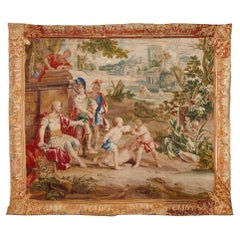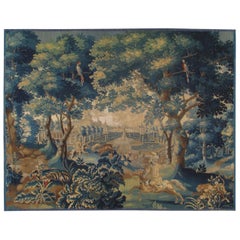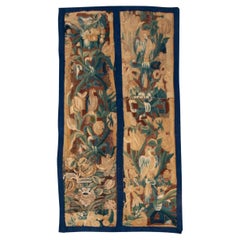Leyniers Family Tapestries
1
to
1
1
1
1
1
Height
to
Width
to
1
1
1
1
1
102
71
41
34
Creator: Leyniers Family
Rare 18th Century Wool and Silk Tapestry by Leyniers
By Leyniers Family
Located in London, GB
Rare 18th century wool and silk tapestry by Leyniers
Belgian, 18th Century
Length 247cm, width 283cm
Beautifully executed and vibrantly coloured, this large tapestry was made in 18th century Brussels by Urbanus (1674-1747) and Daniel III Leyniers (1705-1770).
The tapestry depicts ‘Eumenes’ wrestling match’ or ‘Eumene’s Struggle’ (‘La Lutte d'Eumenes') inspired by the Greek philosopher and historian, Plutarch’s ‘Parallel Lives’ written around second century A.D. King Phillip...
Category
18th Century Belgian Classical Greek Antique Leyniers Family Tapestries
Materials
Textile
Related Items
18th Century Fine Brussels Tapestry, Silk Wool, Green, Blue, Mythological Theme
Located in Port Washington, NY
This very fine Oudenaarde tapestry is one in the series related to the mythological story of Ulysses. It was woven in the late 18th century using t...
Category
18th Century and Earlier Belgian Aubusson Antique Leyniers Family Tapestries
Materials
Wool, Silk
Free Shipping
H 116 in W 147 in D 1 in
French 18th Century Tapestry Fragment
Located in Baton Rouge, LA
This vibrant tapestry fragment hails from 18th century France. Two panels have been recently attached with brilliant blue trimming. The fabric is worn but retains its vibrant floral ...
Category
18th Century French Other Antique Leyniers Family Tapestries
Materials
Fabric, Textile, Tapestry
18th Century Flemish Verdure Landscape Tapestry
Located in New York, NY
A Flemish verdure tapestry from the 18th century, depicting two exotic birds within a profuse landscape, with acanthus plants in the foreground, bloomin...
Category
18th Century European Antique Leyniers Family Tapestries
Materials
Wool
18th Century Tapestry Fragment
Located in New York, NY
Mid 18th century european Tapestry Fragment.
Measures: 1'9'' wide x 2'10'' long.
Tapestries make integral part of the Flemish cultural heritage. Most of the tapestries have religious, mythological and historical subjects as well as hunting and harvest scenes. They are known for their high quality and extended use of colors. The oldest ones were made in the 13th century. The most important production centers were Doornik and Arras. These two centers got a lot of assignments of the Dukes of Burgundy. In the 14th century tapestries...
Category
18th Century French French Provincial Antique Leyniers Family Tapestries
Materials
Wool
18th Century Flemish Verdure Tapestry
Located in New York, NY
A Flemish verdure landscape tapestry panel from the 18th century, featuring a verdant scene with large trees and various foliage and including a lake. Enclosed within a stylized bord...
Category
18th Century European Antique Leyniers Family Tapestries
Materials
Wool
Late 18th C. French Aubusson Tapestry Silk & Wool Seat Fragment
By Aubusson Manufacture
Located in New York, NY
This is a silk and wool seat cover fragment from antique 18th Century French Aubusson chair. Seat cover woven in wools and silks, each with flor...
Category
1680s French Aubusson Antique Leyniers Family Tapestries
Materials
Wool
Late 18th C. French Aubusson Tapestry Silk & Wool Seat Fragment
By Aubusson Manufacture
Located in New York, NY
This is a silk and wool chair back cover fragment from antique 18th Century French Aubusson chair. Chair back woven in wools and silks, each wit...
Category
1680s French Aubusson Antique Leyniers Family Tapestries
Materials
Wool
18th Century French Aubusson Rustic Tapestry
Located in New York, NY
A French Aubusson rustic tapestry from the 18th century, envisioning a wooded landscape in which several youngsters play leapfrog. Enclosed within a scrolling border of fruiting and ...
Category
18th Century French Aubusson Antique Leyniers Family Tapestries
Materials
Wool
18th Century Tapestry
Located in New Orleans, LA
Vibrant colors, bucolic scene.
Category
18th Century French Antique Leyniers Family Tapestries
Materials
Wool, Linen
Aubusson Tapestry 18th Century - N° 1321
Located in Paris, FR
Aubusson tapestry 18th century - N° 1321
Close to the Eiffel Tower, We are a family business specialized in the purchase, sale and expertise of
tapestries, carpets, kilims and t...
Category
1780s French Aubusson Antique Leyniers Family Tapestries
Materials
Wool
Early 18th century Flemish antique tapestry 10x13 Verdure Wool & Silk 297x384cm
Located in New York, NY
Early 18th Century Antique Flemish Tapestry Fine Verdure Wool & Silk
9'9" x 12'7"(10x13) 297cm x 384cm
Circa 1720
"This is a very fine Authentic Antique Flemish wool & silk Tapest...
Category
Early 18th Century French Baroque Antique Leyniers Family Tapestries
Materials
Wool, Silk
H 151.19 in W 116.93 in D 0.3 in
18th Century French Wool and Silk Aubusson Tapestry and Engraving, circa 1750
By Aubusson Manufacture
Located in Milano, IT
La Jeunesse (Youth)
Tapestry
Polychrome wool and silk
France, Aubusson, circa 1750
It measures 107.08 in height x 104.33 in (272 cm height x 265 cm).
State of conservation: good
The tapestry is accompanied by the engraving from which the subject was taken.
The engraving measures 23.50 in x 25.86 in (59.7 cm x 65.7 cm) with the frame.
The Aubusson tapestry has controversial origins: some believe that it was the Saracens who imported this type of work into Europe while other authors believe that the production began at the same time as the marriage between Louis I of Bourbon and Maria de Hainaut in 1310. It was at this time that a considerable importation of tapestries from Flanders into France began, followed shortly thereafter by the importation of their production techniques.
At the beginning of the seventeenth century a royal edict from Henry IV halted the importation of Flemish tapestries, contributing to the subsequent Expansion of Aubusson production. The status of royal manufacture was to be granted only in 1665, even though the Nantes edict caused a drop in production because of the forced migration of weavers to Germany.
The full recovery and the success of the manufacturing took place during the eighteenth century when the great painters and the tapestry manufacturers began to collaborate.
Great French artists of the time and specialist painters, the “cartonniers”, painted “cartons de tapisserie” in oil or tempera, all of which were to be a source for the tapestries. As an alternative to the “cartons”, scenes taken from prints and engravings were freely used.
The tapestry in question, made of wool and silk, is in good condition; the colors are still fresh and the silks, which give brightness to the scene, are well preserved. There are a small number of integrative restorations present, while the lining and the suspension system have been recently refurbished.
The work is made with a flat-weave, according to the custom of the Aubusson manufactures, which is clearly demonstrated by this work since it shows all the technical and material characteristics typical of the first half of the eighteenth-century production: the “Jeunesse” was probably woven in the middle of the XVIII century.
The scene itself is compelling: a rural clearing is depicted, centered around a tall tree with dense fronds with lance-shaped leaves. In the shade of this tree some scenes of courtship can be seen. A couple hugs each other, one is caught stealing a kiss and another, lying softly on the grass, is still at the early stages of courtship: together with the suitor the girl looks with smiling malice at the kissing couple. On the right, two young men practice archery while aiming at a target placed on top of a pole.
The scene, with male and female characters intent on games and gallantry in a festive atmosphere, is taken - faithfully, but in mirror-image - from an engraving, which in turn was itself taken from the painting (now kept at the National Gallery in London, inv. NG103 and part of a series with the four ages of man) by Nicolas Lancret, produced around 1735.
The tapestry is accompanied by a copy of the engraving, which bears, at the bottom, the name of the author (“N. Lancret pinxit”), the name of the engraver (“N. De Larmessin sculpsit”) and four short verses on the subject of love disputes:
Pourquoi tous ces combats si chers a la jeunesse,
Quels frivoles talents veut-elle mettre au jour?
Non: chacun voudroit vaincre aux yeux de sa Maitresse,
La Lice est une Scène ou triomphe l’Amour.
Why all these fights so dear to youth,
What frivolous talents does it want to bring to light?
No: everyone would want to win in the eyes of his Mistress,
The Lice is a Scene where Love triumphs.
At the bottom we read: “A’ Paris chez N. De Larmessin graveur du Roy Rue de Noyer à la 4 (?) porte cochère a droite entrant par la Rue St. Jacques A.P.D.R. [Avec Privilège Du Roy]”.
Nicolas Lancret (1690-1743), along with Antoine Watteau, was a pupil of Pierre Durin and Claude Gillot...
Category
Mid-18th Century French Rococo Antique Leyniers Family Tapestries
Materials
Tapestry, Wool, Silk
H 107.09 in W 104.34 in D 0.4 in
Leyniers Family tapestries for sale on 1stDibs.
Leyniers Family tapestries are available for sale on 1stDibs. These distinctive items are frequently made of textile and are designed with extraordinary care. Prices for Leyniers Family tapestries can differ depending upon size, time period and other attributes — on 1stDibs, these items begin at $31,953 and can go as high as $31,953, while a piece like these, on average, fetch $31,953.


